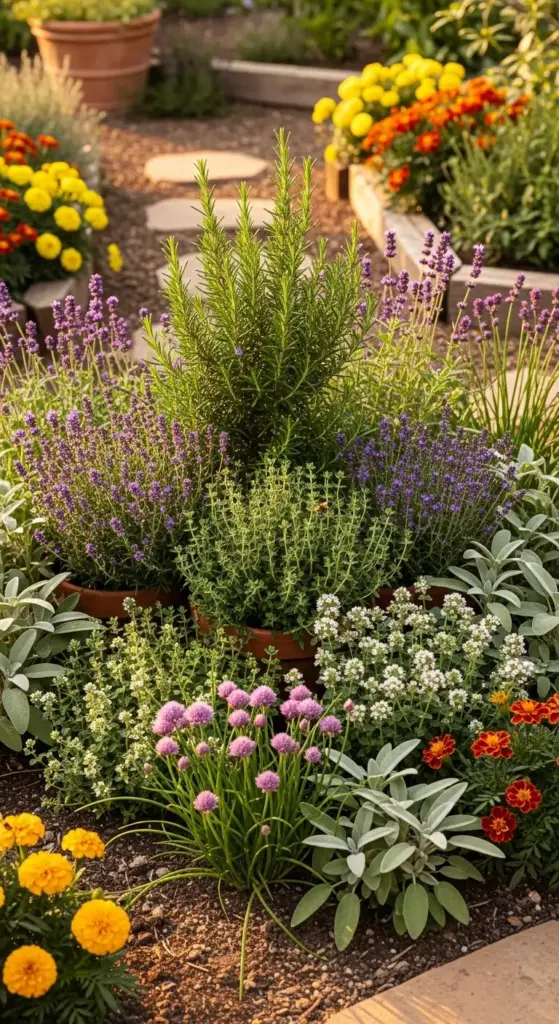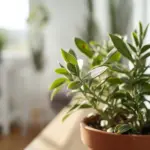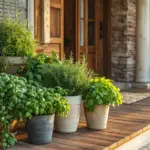4. The Companion Planting Magic Formula

I stumbled onto companion planting by complete accident. My rosemary was planted next to some lavender, and I noticed it was growing way better than the lonely rosemary on the other side of my garden.
That’s when I started researching plant partnerships and discovered this whole underground world of plants helping each other out. It’s like nature’s version of good neighbors.
The Power Trio That Supercharges Rosemary
After three years of experimenting, I’ve found the ultimate rosemary companion plants: thyme, oregano, and sage. This combination is pure magic.
These Mediterranean herbs all have similar water and soil needs, so you’re not fighting different care requirements. Plus, they seem to make each other more aromatic.
I swear my rosemary’s flavor got more intense after I planted thyme right next to it. Maybe it’s competition, maybe it’s some kind of root communication – I don’t know the science, but it works.
The Lavender Partnership (My Favorite Discovery)
Lavender and rosemary together is like the perfect marriage. They both love dry conditions, full sun, and well-draining soil.
But here’s the cool part – lavender attracts beneficial insects that help protect rosemary from pests. I’ve noticed way fewer aphids since I started this pairing.
The visual combo is stunning too. Purple lavender flowers next to rosemary’s blue blooms? Instagram gold right there.
Natural Pest Protection That Actually Works
I used to spray my rosemary with neem oil every week until I discovered companion planting for pest control. Now I barely have any bug problems.
Marigolds planted around the perimeter of my herb garden work like tiny bodyguards. They repel aphids, whiteflies, and even some nematodes.
Basil is another pest-fighting superstar. Plant it near rosemary and you’ll see fewer spider mites and thrips. Plus, you get fresh basil for cooking – win-win.
The Chive Secret (This One Surprised Me)
Chives might look innocent, but they’re like the tough guy of the herb world. They repel aphids and even some larger pests like rabbits.
I planted chives in a circle around my rosemary containers, and the difference was noticeable within weeks. Fewer bugs, healthier plants, and I get fresh chives for my scrambled eggs.
The purple chive flowers are gorgeous too – they add height and color variation to herb garden designs.
Plants That Kill Rosemary Dreams
Okay, let’s talk about the companion planting mistakes that nearly destroyed my herb garden. Learn from my pain here.
Never plant rosemary near mint. I repeat – never. Mint is a water hog and will compete aggressively for resources. Plus, mint spreads like crazy and will take over everything.
Tomatoes and rosemary don’t mix either. Tomatoes need way more water and nutrients, so you end up either drowning the rosemary or starving the tomatoes.
I also learned that impatiens and begonias are terrible neighbors. They need constant moisture, which creates the perfect environment for rosemary root rot.
Creating Instagram-Worthy Layouts
Here’s my formula for herb garden design that looks amazing and functions perfectly:
Center: Tall rosemary as the focal point Middle ring: Medium-height herbs like oregano and thyme Outer ring: Low-growing companions like creeping thyme or prostrate rosemary varieties
This creates natural height variation and looks intentional, not random.
The Color Coordination Game
I’ve gotten obsessed with color combinations in my herb plantings. Purple-flowered rosemary with yellow-flowered thyme creates this gorgeous contrast.
Silver-leafed plants like artemisia or dusty miller make rosemary’s green foliage pop. It’s like having a natural backdrop that makes everything look more vibrant.
For fall interest, I add purple sage – the burgundy leaves look incredible next to rosemary’s evergreen foliage.
My Three-Season Design Strategy
Spring: Focus on fresh green growth with parsley and chives as bright accents Summer: Let the flowering herbs take center stage – lavender, rosemary, and oregano blooms Fall: Add ornamental kale or purple cabbage for color when flowers fade
This keeps the garden interesting year-round instead of looking boring in off-seasons.
The Container Combination That Never Fails
For container herb gardens, I use what I call the “Mediterranean medley” approach:
One large pot with rosemary in the center, surrounded by smaller pots of thyme, oregano, and sage. Group them close together so they look like one big planting.
This way, each plant gets its own soil and drainage, but they still benefit from being close companions.
Spacing Secrets for Maximum Impact
Plant spacing took me forever to get right. Too close and they compete; too far and you lose the companion benefits.
For rosemary and lavender, I plant them about 18-24 inches apart. Close enough to look intentional, far enough that air circulation prevents fungal issues.
Smaller herbs like thyme can go closer – maybe 12 inches from the rosemary base.
The Pollinator Magnet Effect
One unexpected bonus of companion planting – my herb garden became a bee and butterfly paradise. The combination of different flowering times means something’s always blooming.
Rosemary flowers in late winter/early spring, lavender in summer, and sage in fall. It’s like running a pollinator buffet all season long.
My Biggest Design Mistake (Don’t Copy This)
I once tried to create a formal herb knot garden with rosemary as the main structure. Looked amazing on paper, disaster in reality.
Rosemary grows too irregularly for formal designs. It wants to be a little wild and natural-looking. Fighting its natural growth habit just creates more work and stressed plants.
Think your rosemary is tough enough to handle anything? Wait until you discover the temperature mistakes that can kill even the hardiest plants overnight! Click “next” to learn The Temperature Shock Prevention Method – these simple techniques will protect your rosemary through unexpected weather changes and seasonal transitions.









GIPHY App Key not set. Please check settings